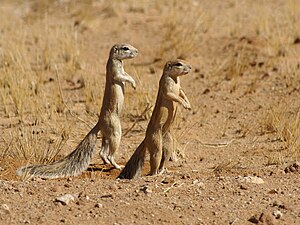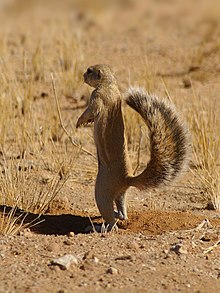Cape ground squirrel
| Cape ground squirrel | ||||||||||||
|---|---|---|---|---|---|---|---|---|---|---|---|---|

Cape ground squirrel ( Xerus inauris ) |
||||||||||||
| Systematics | ||||||||||||
|
||||||||||||
| Scientific name | ||||||||||||
| Xerus inauris | ||||||||||||
| ( Zimmermann , 1780) |
The Cape ground squirrel ( Xerus inauris ) is a species of the African ground squirrel .
Appearance
As with all bristle squirrels, the fur is stiff and bristly. It is mostly cinnamon brown in color, the belly, sides of the neck, the insides of the legs and parts of the face are white. On both sides of the body a horizontal white stripe extends from the shoulder to the hind legs. The tail has two black cross bars at the base.
The head-torso length is 23.5 to 28.2 cm, with a 19.4 to 21.1 cm tail. Males are usually slightly larger than females and reach a weight of 10% more (up to 650 g).
distribution
The Cape Bristle Squirrel lives in deserts and semi-deserts in the territories of South Africa , Namibia , Botswana and Lesotho . In northern Namibia, the Cape bristle squirrel is being replaced by the Kaokoveld bristle squirrel ( Xerus princeps ), the only bristle squirrel species with which the Cape bristle squirrel lives sympathetically .
The habitat can be largely without vegetation, overgrown with grass or with shrubs. Outside temperatures of over 39 ° C are tolerated, as well as floor temperatures of up to 62 ° C.
Way of life
Cape bristle squirrels are diurnal . They live in small colonies in buildings they have dug themselves, the tunnels of which can have an area of 700 m² and have two to a hundred entrances. Colonies consist either only of females and their offspring, or only of males. Males only visit the females' structural systems for a short time in order to mate. A female den comprises one to four adult females and their offspring. A male den consists of up to 19 males that are not related to each other. While female burrows are fixed in composition, male burrows are loose associations to which new individuals are constantly added while others migrate.
Buildings offer protection from extreme outside temperatures and from enemies. With a warning call, other members of a group are warned of an enemy. Both males and females often share burrows with meerkats and / or fox mongooses . Food is not stored in the burrows.
The gestation period is 42 to 49 days. A litter consists of one to three boys. These remain under construction for about 45 days and are only taken care of by the female. The boys are initially naked and blind. From the seventh day of life the fur begins to sprout, and around the 35th day the eyes open. Soon after leaving the burrow, the young are no longer suckled and find their own food. Cape bristle squirrels are ready to breed year-round, but rarely raise more than one litter per year.
The diet of the Cape Ground Squirrel consists of grasses, herbs, leaves, roots and fruits, and sometimes insects as a supplement.
Hazardous situation
The Cape Bristle Squirrel is classified by the International Union for Conservation of Nature IUCN in the Red List of Threatened Species as a widespread species for which no threats are known, and classified as Least Concern .
literature
- Douglas A. Skurski, Jane M. Waterman: Xerus inauris. In: Mammalian Species . No. 781, 2005, pp. 1-4, doi : 10.1644 / 781.1 .
Web links
Individual evidence
- ↑ Xerus inauris in the endangered Red List species the IUCN 2010. Posted by: Griffin, M. & Coetzee, N., 2008. Accessed on March 16 of 2010.


